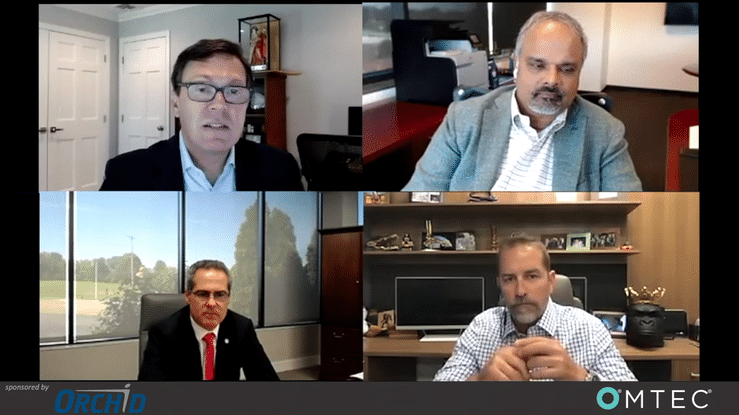
Presidents of three orthopedic companies spoke with optimism as they discussed market growth and technology adoption as part of an OMTEC® keynote in mid-June.
Although Jacob Paul of Medtronic, Benny Hagag of MicroPort Orthopedics and Albert DaCosta of Paragon 28 represented companies of different sizes and market segments, their comments echoed each other throughout the conversation. They answered questions about how their companies are prioritizing their portfolios and responding to COVID more than a year into the pandemic. What transpired from the discussion was an understanding of how technology is shaping orthopedics.
Orthopedic Recovery is Underway
Return of Procedures and Market Growth
The global orthopedic market dropped -10.6% in 2020 vs. 2019 amidst COVID, according to our estimates. While the opening months of 2021 saw a lower number of procedures, the panel noted that procedure volumes are returning and the market recovery is underway, especially in the U.S.
Medtronic has experienced spine procedures close to pre-COVID levels in the U.S. While some international markets continue to be challenged, the fundamentals for the recovery remain strong, said Jacob Paul, Senior Vice President and President of Cranial and Spinal Technologies, Medtronic.
Benny Hagag, President of MicroPort Orthopedics, said that the recovery is more of a U-shape than the V-shape originally anticipated. The joint replacement market remains soft partially due to patient behavior—that is, people are hesitant to return for surgery, and others are postponing surgeries to enjoy summer. MicroPort expects an improvement in the latter part of the third quarter.
“Overall, when we talk with surgeons and providers, we are seeing recovery and availability in the system that was not there a few months ago,” Hagag said. “Europe has more availability and services that are offered by hospitals than patients are willing to take at the moment.”
The foot and ankle market in which Paragon 28 plays is mostly elective, which means Q4 is usually the company’s strongest quarter. Albert DaCosta said he is expecting a strong third and fourth quarter.
“We’re seeing pre-COVID levels now, and Q4 [2020] for us was about 22% improved over Q4 of the previous year,” DaCosta said. “We’re optimistic about the recovery.”
Lessons Learned from COVID
While orthopedic companies expect a return to more predictable performance in the coming year, there’s no denying that COVID has changed businesses. The panel emphasized their companies’ flexibility in response to the pandemic and the resiliency of their teams.
For one, COVID created an opportunity for companies to modernize their business, DaCosta said. He provided examples of implementing hybrid work environments and leveraging technology to cut back on travel and maintain internal connections and service cases outside the O.R.
Hagag said that MicroPort committed to strengthening its relationships with its customers and business partners, which even meant financially supporting groups like its distributors. From there, the company executed with flexibility.
“I think that we are coming out of this pandemic much stronger as a company and with better tools, better capabilities to actually be more competitive and be more attentive to our patients and customers,” Hagag said.
The adoption of technology during the COVID era will have long-term implications on how companies communicate and how they think of product innovation, Paul said. He repeated the need for innovation that drives value like data, AI, robotics and patient experience.

Lawrence Biegelsen of Wells Fargo, Jacob Paul of Medtronic, Benny Hagag of MicroPort Orthopedics and Albert DaCosta of Paragon 28 provided insight on the state of orthopedics during the OMTEC keynote. Click on the image to access the video.
Technology Perspectives
Companies Prioritize Enabling Technologies and Digital Tools
The orthopedic industry is at an inflection point for technology adoption. Large joint replacement and spine companies have developed and deployed robots, but the advancement of technology extends well beyond that surgical assistance. The panel was asked what role technology will play in orthopedics in the near and long term. In short, the executives said companies would need to add technology to their portfolios to thrive.
MicroPort expects a significant shift toward digital tools that support the whole episode of care, Hagag said. That technology includes tools that better inform the surgeon for the procedure before entering the O.R. and tracking and monitoring patients in their rehab. MicroPort recently partnered with PatientIQ on a patient-engagement tool that considers 90 days both before and after an orthopedic procedure.
Medtronic’s Mazor X Stealth robotic system is possibly its most known technology, but Paul noted that it’s just one tool in the ecosystem.
“The convergence of robotics and robotic-assisted surgery, data-enabled decision-making and AI-enabled planning and pushing fewer implants, that’s going to change spine surgery to make it more predictable and reproducible and drive better outcomes,” he said.
Medtronic is focusing on acquisitions that provide the company AI-driven planning and patient-specific implants, like its recent purchase of Medicrea, and smart technologies like wearables.
“This is going to transform spine, and it’s also going to differentiate ourselves,” Paul said. “Companies that have the entire ecosystem will stand out.
DaCosta was adamant that companies of all sizes need to look beyond their implant portfolios.
“If a company is too small to invest in that type of technology or frankly if it’s just outside of their expertise, I think it’s going to require people to get creative and find better partnerships and alignments that give them access to that type of technology,” he said. “I just think the future, again to be redundant on that topic, is going to be driven by this type of smart enabling technology.”
Paragon 28 is investing in preoperative planning tools and evaluating technology across the board—robotics, AI, 3D modeling, patient-specific instruments and implants. In May, the company introduced its FasTrac Distal Tibia Alignment System, which features proprietary laser technology developed to provide a precise visual reference point during component alignment.
Additive Manufacturing Grows in Adoption
Orthopedic device companies continue to expand their portfolios with additively manufactured devices. The panel discussed the benefits of utilizing additive manufacturing and noted that it would become necessary to build out product portfolios.
For example, in June, Paragon 28 announced it acquired the product lines of Additive Orthopaedics, including the Additive 3D-printed Patient Specific Talus Spacer.
“We believe that additive manufacturing is a part of advanced, enabling technologies,” DaCosta said. “We think patient-specific implants and instruments will be a critical part of the future of foot and ankle surgery.”
Paul echoed DaCosta’s statements saying, “We see that over time, as we integrate data and AI into the whole technology ecosystem based on predictive analytics, we’ll be able to tailor our offering to the patient, the pathology and even the surgeon and their approach. Tying that with patient-specific implants, additive manufacturing gives us the technology to be able to do that.”
Hagag said that in addition to technology benefits, additive offers manufacturing flexibility.
“What is very significant is that it opens opportunities to design and manufacture implants that you can’t do conventionally,” he said. “Additive opens opportunities for the engineers to focus more on the patient and deliver implants better suited to fit the bone and eventually get better bone/implant integration. Beyond that, additive manufacturing provides significant flexibilities because you can manufacture different implants on one plate at the same time.
“It’s more demanding with respect to setup and preparation. But, at the end of the day, the machine can print the shapes and sizes and types of implants based on the specific needs. It adds to manufacturing flexibility, cost-effectiveness and improvement in the quality of implants that we can, as an industry, deliver to our patients in the future.”
This is just a glimpse at the comments made during the hour-long discussion. You can view the entire keynote at OMTECexpo.com.
CL
Carolyn LaWell is ORTHOWORLD's Chief Content Officer. She joined ORTHOWORLD in 2012 to oversee its editorial and industry education. She previously served in editor roles at B2B magazines and newspapers.




